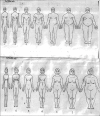Body Size Perceptions and Weight Status of Adults in a Nigerian Rural Community
- PMID: 26500794
- PMCID: PMC4594350
- DOI: 10.4103/2141-9248.165247
Body Size Perceptions and Weight Status of Adults in a Nigerian Rural Community
Abstract
Background: Overweight and obesity are now recognized worldwide as increasing public health problems throughout the life course and wrong perception of one's body size may reduce the motivation for an overweight person to lose weight.
Aim: This study was conducted to investigate how Nigerian rural dwellers perceive their body size and how their perception agrees with their body mass index (BMI).
Subjects and methods: A cross-sectional sample of 183 adults living in a rural community, South-West Nigeria was randomly recruited into the study. Their verbal and visual body size perceptions were assessed through structured questions and body images. Descriptive and inferential statistics were used to analyze the data.
Results: Thirty-five percent (64/183) of participants were classified as either overweight or obese by BMI. More than half of the participants perceived themselves as normal weight. More women perceived themselves to be obese than men in both verbal and visual perceptions. Based on BMI classification, 43% (79/183) and 54% (98/183) of participants misperceived themselves in verbal and visual perception, respectively. Underestimation of body size was higher in men (38.3%, 36/94) while overestimation was higher in women (9.0%, 8/89). Men had consistently higher values of kappa coefficient which indicate greater agreement than women in both types of perception.
Conclusion: We found considerable gender differences in body weight perception of adults in the Nigerian rural community. A large proportion of these rural dwellers could not appropriately classify their weight status; and over 30% (64/183) and nearly 50% (92/183) of them underestimated their own body weight in verbal and visual perceptions respectively.
Keywords: Body perception; Overweight; Rural community; Weight status.
Conflict of interest statement
Figures
References
-
- Goodman E, Hinden BR, Khandelwal S. Accuracy of teen and parental reports of obesity and body mass index. Pediatrics. 2000;106:52–8. - PubMed
-
- Akinpelu AO, Oyewole OO, Oritogun KS. Overweight and obesity: Does it occur in Nigerian adolescents in an urban community? Int J Biomed Health Sci. 2008;4:11–7.
-
- Calle EE, Rodriguez C, Walker-Thurmond K, Thun MJ. Overweight, obesity, and mortality from cancer in a prospectively studied cohort of U.S. adults. N Engl J Med. 2003;348:1625–38. - PubMed
-
- Lucove JC, Huston SL, Evenson KR. Workers’ perceptions about worksite policies and environments and their association with leisure-time physical activity. Am J Health Promot. 2007;21:196–200. - PubMed
-
- Burns CM, Tijhuis MA, Seidell JC. The relationship between quality of life and perceived body weight and dieting history in Dutch men and women. Int J Obes Relat Metab Disord. 2001;25:1386–92. - PubMed
LinkOut - more resources
Full Text Sources
Other Literature Sources


